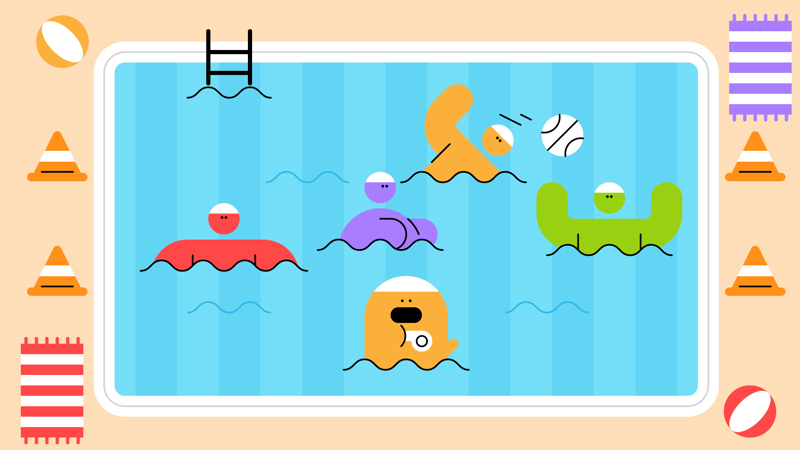
Learn to play basic water polo
You’ll need
- Whistles
- A ball that floats
- Goal markers
- A way to keep score
Set up the pitch
- Place a pair of goal markers on each side of the water. If you don’t have posts, these could be cones on the side.
- Split the group into two teams. One player will be the goalkeeper while the rest will be outfield players. The teams are trying to get the ball into the opposing team’s goal area. The winning team is the one with the most goals at the end.
Water polo rules
- To start the game, the ball is thrown from the side into the middle of the water. Possession goes to the player that reaches it first.
- Any player holding the ball is not allowed to move. They must throw the ball within 30 seconds of receiving it.
- A game is split into four quarters, each four minutes in length. The teams should change ends at each break, and consider swapping their goalkeeper.
- Listen for the whistle to know when to start and stop.
Reflection
This activity was about being physically active and trying a new sport in the water. What other sports could you adapt to play in water? What were the challenges of playing in the water, compared to a ball sport on land?
This activity was also about working in a team. How well did your team work together? How did you communicate with each other while in the water? What could you have done differently to improve your teamwork?
Safety
All activities must be safely managed. You must complete a thorough risk assessment and take appropriate steps to reduce risk. Use the safety checklist to help you plan and risk assess your activity. Always get approval for the activity, and have suitable supervision and an InTouch process.
- Water games and activities
Be careful when doing activities with, in, or near water. Check surfaces and reduce the risk of slipping where possible. Make sure you have appropriate supervision for this activity.
You must always:
- Complete a risk assessment
- Have the right ratios of number of adults to provide suitable supervision
- Set up an InTouch process
- Know what to do in an emergency
- Share information with parents and carers with an activity information form
- Get approval from your commissioner
Be safe in water:
Everyone should be able to swim 50 m wearing the clothing or equipment for the activity. Non-swimmers will need additional support.
Water can be dangerous - be aware of the risks.
The category of water depends on how safe the water is. Use our waterways directory to check.
Be sure to manage the group when near water, keeping everyone safe.
Look at the extended rules for water polo to increase the challenge of this simplified version. Change the size of the pitch or play in the shallows if there are less confident swimmers in the group
Add or take away rules for the needs of the group.
All Scout activities should be inclusive and accessible.
